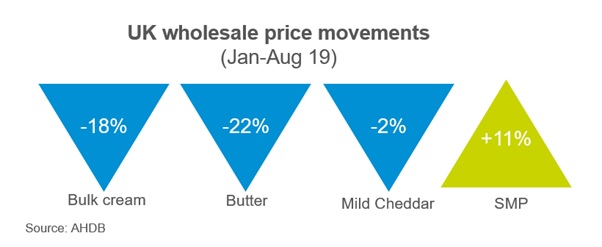Are milk price cuts in line with the market?
Thursday, 5 September 2019
By Patty Clayton
The high levels of milk production in the UK this year are now starting to have a significant impact on farmgate milk pricing; especially for those supplying the liquid milk market.
On average, milk prices have been cut by 1.35ppl between January and September1, although these have ranged between 0.24ppl to 3.6ppl depending on the buyer.
Milk deliveries hit 25-year record highs in almost every month from January to June, boosting milk supplies by over 200 million litres compared with last year. According to Defra, most of this extra milk has been used to make butter and milk powder, or been used in the liquid milk market2. Very little has found its way into cheddar production.
In response to the added volumes, spot milk prices have been depressed through most of the year. Prices for fat (cream and butter) on wholesale markets have also been gradually declining since the beginning of the year. While the individual month-on-month changes have not been dramatic, the net impact has built up. Between January and August, butter prices have dropped 22% and bulk cream prices by 18%. Cheddar prices have remained stable, as there has not been as much pressure from additional volumes.

When looking at trends in the Milk Market Value, the overall impact of the declining market returns has not been dramatic. Falling fat values have been balanced out by stable cheese prices and rising milk powder prices. Some processors will have mitigated their exposure to oversupplied markets by working closely with their producers to align production to market needs.
However, those processors with a higher reliance on trading liquid milk or fats, either due to increased milk deliveries or the structure of their customer base, will have seen a bigger hit to their overall returns. This becomes evident when looking at which buyers have made the largest cuts to farmgate milk prices this year.
Milk prices paid by buyers are, of course, also impacted by other factors including changes to available processing capacity, competition for milk in the market, contract negotiations and cash flow considerations. During the summer and autumn last year, concerns over the lack of forage meant buyers, in general, lifted their milk prices more than we would have expected purely as a result of market returns. While those cumulative movements were back in line with the market drivers by the spring, some of the current price cuts may be in response to pressures on buyers arising from other business events.
Whether the farmgate price drops are justified by the market, or not, they are putting further pressure on the Milk to Feed Price ratio, which gives an indication of the financial pressure farmers are under. During such periods it becomes even more critical for farmers and processors to work in tandem to deliver what the market requires as efficiently and effectively as possible.
Looking ahead, expectations of a return to more normal yields over the winter months should reduce some of the pressure on markets3, and bring some support to farmgate milk prices.
1. Based on announced price cuts reported on the AHDB league table
2. Defra utilisation figures do not split out skim and whole milk powders. Volumes of liquid milk that leave the primary dairy are considered to be drinking milk, although it may be used in the manufacture of other food products.
3. The forward looking analysis does not take into account impacts from leaving the EU without a deal.
Sign up to receive the latest information from AHDB.
While AHDB seeks to ensure that the information contained on this webpage is accurate at the time of publication, no warranty is given in respect of the information and data provided. You are responsible for how you use the information. To the maximum extent permitted by law, AHDB accepts no liability for loss, damage or injury howsoever caused or suffered (including that caused by negligence) directly or indirectly in relation to the information or data provided in this publication.
All intellectual property rights in the information and data on this webpage belong to or are licensed by AHDB. You are authorised to use such information for your internal business purposes only and you must not provide this information to any other third parties, including further publication of the information, or for commercial gain in any way whatsoever without the prior written permission of AHDB for each third party disclosure, publication or commercial arrangement. For more information, please see our Terms of Use and Privacy Notice or contact the Director of Corporate Affairs at info@ahdb.org.uk © Agriculture and Horticulture Development Board. All rights reserved.

